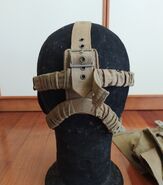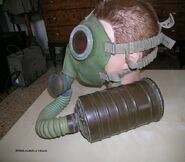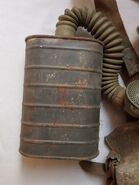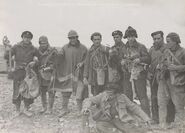The Penna respirator sometimes referred to just as Penna mask, was the first domestic design gas mask adopted by the Italian Army after the Great War, succeeding the English SBR. The mask was named after Lorenzo Penna, the Generale del Genio (military engineering general) who founded the S.C.M. (Servizio Chimico Militare, chemical military service).
Mask overview
The Penna mask's faceblank was made of a two layers rubber, green and textured on the outside while beige and smooth on the inside. Inside the mask there was an internal divider made of rubber and synthetic sponge, which separated the faceblank in two parts, reducing dead space and helping to prevent fogging while wearing the mask. The faceblank had the following parts attached:
- The head harness, with six elastic straps. Modified models have only 5 straps and use the M.31-style harness
- The "Triplex" eyepieces were made of three layers, two glass ones and a cellulose one that tended to become orange over time. To even to prevent fogging, anti-fogging lenses could be put using eye clips
- The inlet-outtake piece was connected to the mask at the bottom and tends not to point straight forward but to bend to one side because of the soft rubber. It has three holes: one for the hose, one for the connection to the mask and the third was for the exhale valve, an aluminium disc with two complementary thin rubber discs kept still by a lid and sealed with a rubber ring; inside there was an inlet valve to allow a longer duration of the filter.
- The filter itself was attached through a pleated hose to the aforementioned piece and itself was stored in its bag.
6-straps variant
Modified (5-straps) variant
Filter
The original Penna mask was provided with a large box filter coloured green. This filter is often referred to as "Piatto", which means flat, as it's the only Italian military filter to not be round. During later use and especially after 1933, the mask was connected to an M.33 filter or more rarely an M.31 filter.
Kit
The mask came in a satchel made usually of green (rarely brown) rubberized cloth: it had two sections, one for the mask and the other for the filter and hose. The filter section had holes to allow airflow. Inside the side pocket, there were a pair of anti-fogging lenses, specifically made for this mask. The main strap had a special buckle to be shortened when the mask was in use; the small string on the side of the satchel helped to keep the aforementioned firmly onto the wearer's chest. Some kits had the satchel replaced with an M.31 one, in case the first broke.
Service life
Adoption
During the late '20s, the Italian Army was seeking renovation in its chemical protection equipment. Since the end of the war, in fact, the Army was still using Small Box Respirators, which were considered outdated by every standard after the second half of the '20s. Because of that push, the army adopted the Penna respirator in 1928, naming it after the deceased general Lorenzo Penna. It resembled the SBR functionally but had a very different construction. This mask was made integrally of rubber, which was something quite uncommon at the time, it had Triplex glasses and an internal divider, a feature that was almost unseen in military masks at the time.
Problems and replacement
Even though this mask had very innovative features, it had some problems in its design, which are in order of decreasing severity:
- The soft rubber made the inlet-outtake piece wobble too much, restraining airflow and encumbering respiration
- The inlet and exhale valves were not as easily replaceable as deemed necessary, and the same goes for the eyepieces and straps, both of which required special tooling to be replaced
- The filter plug system wasn't practical and the plugs could be easily lost.
Because of these reasons, the Army adopted the M.31 in 1931, which fixed these problems and others too. The Penna, therefore, started slowly being ruled out of service.
The 1933 upgrade
In 1933 the Penna respirators were upgraded with a new 5-points elastic head harness, which would become standard in Italian military masks. To switch to the new set-up, the masks were deprived of the old harness by ungluing the 4 lower straps and by cutting the rubber where the two upper straps were held. This process was executed to almost all masks, making Penna respirators with the original setup extremely rare. The main use to the newly upgraded Penna respirators was to train soldiers in the use of gas masks, and they were issued with their old bag and an M.33 filter. On rare cases, Penna masks were used for second-line duties, like terrestrial navy units, and in even rarer cases they were used by Italian soldiers or native rebels during the Spanish civil war.












































